
California 26 Feb - 28 March . . 28 March - 18 April |
France 18 April - 16 May |
Italy 16 - 23 May
France 2 23 May - 6 June |
On to Cambodia 4 - 28 July . . 28 July - 19 August
Home | Where in the world? |
Little Henry | Big Al
G'day . . . . . . . . . . . . . . . . . . . . . . . . . . . . . . . . . week ending 13 June |
 London! London!Like many of the monuments visited in continental Europe, it is the scale of the structures that impresses anew each time you visit. How is it that the memory does not capture it the first time, or even subsequently? Big Ben is another of those structures. Standing near it, it broods it is so big. Its ringing tones call out with authority. They say "this is the time, no questions asked." Something the rumble of traffic can never drown. |
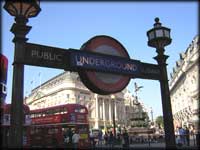 The underground railway system, so famous with its
spaghetti drawing of connections, is a quick way around London. But it is disorienting too, as the relative position of places is
lost underground - particularly with a map that is only schematic. By far the best, and cheapest way, to travel around central London
is the bus system, where you can see everything and all the things in between. The underground railway system, so famous with its
spaghetti drawing of connections, is a quick way around London. But it is disorienting too, as the relative position of places is
lost underground - particularly with a map that is only schematic. By far the best, and cheapest way, to travel around central London
is the bus system, where you can see everything and all the things in between.Since a tariff was introduced for traffic in central London, the number of vehicles has dropped such that it is mostly buses and London taxis that ply the streets. The numbers of both is staggering. For those with a keen eye, you may recognise Piccadilly Circus. |
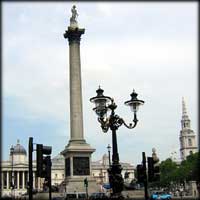 Trafalgar Square, London. Every
city seems to have a centre. Horatio up there with the pigeons and the clouds. Saint Martin in the Fields. The National Gallery. The
empty plinth. The fountains. The traffic lights. The roads that offer so many directions to choose from. Trafalgar Square, London. Every
city seems to have a centre. Horatio up there with the pigeons and the clouds. Saint Martin in the Fields. The National Gallery. The
empty plinth. The fountains. The traffic lights. The roads that offer so many directions to choose from.Go to top of page |
 The National Gallery and a quick lesson on why British museums are different from others
in Europe. They are free to enter. The National Gallery and a quick lesson on why British museums are different from others
in Europe. They are free to enter.I do not know if it is this, or if there are other factors, but the museum experience here is much more pleasant. There are no queues to get in. Once in, there are no jostling crowds. There is a sense of time and space to see the exhibits, no less famous or prestigious than the museums with paid entry. The first painting I laid eyes on upon entry to the National Gallery at Trafalgar Square was 'Sunflowers' by van Gogh. |
 Covent Garden and a more refined style of busking with violins and cellos
playing classical music. Echoing through the building so as to be heard from a long way away and played with such verve and vigour. Covent Garden and a more refined style of busking with violins and cellos
playing classical music. Echoing through the building so as to be heard from a long way away and played with such verve and vigour.
|
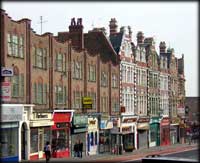 There is something about seeing a London street and being able to tell
immediately that it is English and could not be anywhere else. For a city that lies in a country with a reputation for rain at all times
of the year, it is perhaps surprising that there are no awnings or verandahs. Not over the footpaths for the pedestrians, nor over the
windows in the shops or houses or flats or units. And because most of the frontages on London streets were built so long ago, one
never sees a new frontage to see what style they build in now. It is all old, but solid, and likely to last a lot longer yet. There is something about seeing a London street and being able to tell
immediately that it is English and could not be anywhere else. For a city that lies in a country with a reputation for rain at all times
of the year, it is perhaps surprising that there are no awnings or verandahs. Not over the footpaths for the pedestrians, nor over the
windows in the shops or houses or flats or units. And because most of the frontages on London streets were built so long ago, one
never sees a new frontage to see what style they build in now. It is all old, but solid, and likely to last a lot longer yet.
|
|
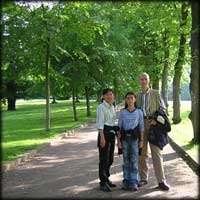 England has its own shade of
green. Even in London it is apparent. The grass fairly springs out of the ground. The trees sprout new leaves and all glows green. England has its own shade of
green. Even in London it is apparent. The grass fairly springs out of the ground. The trees sprout new leaves and all glows green.
What is hard to do is to capture this greenery. Cameras tend to have their own colour bias, and then too do digital editing programs and, of course, you seeing the web version of a photo have the subleties of colour shades totally removed by the compression of the picture to get it to load in as short a time as possible. This is Crouch End in North London, not a bad little area with plenty of parks within walking distance. |
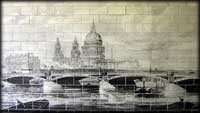 In London they have a fairly famous house of God. They tend to call it Saint Paul's.
Unfortunately for those with the responsibility for maintaining the physical characteristics of the edifice, it needs occasional
maintenance. Unfortunately for the tourists visiting in 2004, they are doing it this year. In London they have a fairly famous house of God. They tend to call it Saint Paul's.
Unfortunately for those with the responsibility for maintaining the physical characteristics of the edifice, it needs occasional
maintenance. Unfortunately for the tourists visiting in 2004, they are doing it this year.Thus the church is not worth looking at from the outside presently as it is mostly scaffolding and cement mixers and trucks and large canvases and dust. Oh, well. At least the bridge underpass under London Bridge has a lovely tile wall of its potential. |
 Grafitti is an interesting
phenomenon. The usual spraycan stuff is found in every country, though some tend to do it better than others. In Italy and Germany
it seems to be of a higher standard with a real effort at style for the Italians and draughtsmanship for the Germans. The French
efforts tend to be scrappy and the English unimaginative. Grafitti is an interesting
phenomenon. The usual spraycan stuff is found in every country, though some tend to do it better than others. In Italy and Germany
it seems to be of a higher standard with a real effort at style for the Italians and draughtsmanship for the Germans. The French
efforts tend to be scrappy and the English unimaginative.However, the English have this stencil style, which may or not be grafitti, which is both imaginative and endearing. You have to like it. Go to top of page |
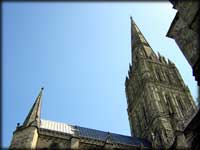 The top bit of Salisbury Cathedral. The bit that can be seen
for miles around and was not on the plans when the building first went up. And then along came some bright spark and said, 'you know,
this building could do with an extra 6,400 tons of masonry on top of it that it was never designed to bear'. And so they plonked it
right there. The top bit of Salisbury Cathedral. The bit that can be seen
for miles around and was not on the plans when the building first went up. And then along came some bright spark and said, 'you know,
this building could do with an extra 6,400 tons of masonry on top of it that it was never designed to bear'. And so they plonked it
right there.Now what you can probably see from your viewpoint is that the very tip of the spire is not in the right place. Of course it is on the very top of the spire, but it is 75 cm off centre. I suppose when you go up 123 metres vertically, what is an error of less then a metre horizontally? Despite the threat of the whole central structure coming down around our ears, it didn't. and the visit proved very worthwhile, including, in the chapter house, one of the four extant copies of the Magna Carta. The Magna Carta was made about the same time as the cathedral - over 700 years ago and, like it, in very good order. |
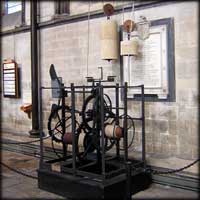 One of the
oldest working clocks in the world ticks away in Salisbury Cathedral. The clock requires constant winding by pulling up the sandstone
wieghts on long ropes to the ceiling. The clock has no clockface on it, as it was designed - and designed very well - to denote the
hours only. One of the
oldest working clocks in the world ticks away in Salisbury Cathedral. The clock requires constant winding by pulling up the sandstone
wieghts on long ropes to the ceiling. The clock has no clockface on it, as it was designed - and designed very well - to denote the
hours only.Connected to the chuch bells, it would chime out the hours with a simple mechanism for determining the number of times the bell is struck corresponding to the hour. While the clock still runs, it is no longer connected to the bells so that it does not disturb other activities in the cathedral. In the days that this clock was made, there were no screws or nuts and bolts. It is held together with a carpenter's mortice, though it is cast iron. Remarkable. |
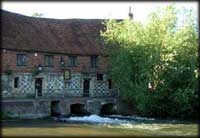 The olde mill driven by paddles in the river - in this case the Avon in Salisbury. These days the
water still runs, but the only grist in the mill is the conversation of the patrons to the pub now occupying the premises. The olde mill driven by paddles in the river - in this case the Avon in Salisbury. These days the
water still runs, but the only grist in the mill is the conversation of the patrons to the pub now occupying the premises.Go to top of page |
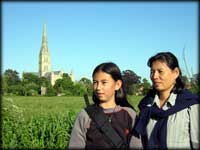 Salisbury Cathedral from downstream along one of the tributaries of the Avon River,
where a path takes you past fields of sheep (yes, Suffolk), the olde mill on the river, fetching pools of water and playing fields. Salisbury Cathedral from downstream along one of the tributaries of the Avon River,
where a path takes you past fields of sheep (yes, Suffolk), the olde mill on the river, fetching pools of water and playing fields.
|
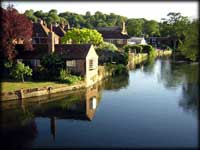 One of the aspects from a bridge across the Avon River. Late afternoon sun improves many an
attractive view to make it almost gorgeous. One of the aspects from a bridge across the Avon River. Late afternoon sun improves many an
attractive view to make it almost gorgeous.
|
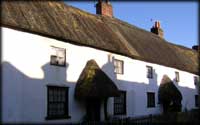 Thatching as a form of roofing is still in in many places. While not easy or cheap to effect,
presumably there are requirements in certain places to maintain them. They are certainly fetching but, as Warwick township found
out years ago, highly flammable. As opposed to highly inflammable, I suppose. Thatching as a form of roofing is still in in many places. While not easy or cheap to effect,
presumably there are requirements in certain places to maintain them. They are certainly fetching but, as Warwick township found
out years ago, highly flammable. As opposed to highly inflammable, I suppose.
|
 The
rocks of Stonehenge still stand. As does the mystery as to what they were really all about, and any certainty as to their
construction. The
rocks of Stonehenge still stand. As does the mystery as to what they were really all about, and any certainty as to their
construction.No doubt it is a good thing that there are still some mysteries in the world. To wonder at the achievements of past generations and to wonder at what was lost through circumstance, fate, accident, neglect, ineptitude, carelessness or war. This enables us to wonder that what we have now might be lost, it may not just go on forever. Everything changes, that is the one thing about life that doesn't change. It doesn't always have to get better, as events last century showed. I think what brought this home was the events of just 60 years ago in the second world war. Travelling around France, Italy and England and coming face to face with the consequences of the military objectives of silly men and their silly wars. Bridges, buildings, churches, priceless monuments and artifacts just mown down in the path of the military mind. The pointers to history threatened and often annihilated. Perhaps the most significant of the places I visited in this respect was the Ponte Vecchio bridge in Florence, Italy where the literature describes the fact that it still survives while all other bridges in Florence were bombed away; and ascribe this deliberate decision to a military man, albeit one whose identity is uncertain, variously either the local german commander or the Fuhrer himself. What element in that man allowed the considerable military risk of such a decision? One hopes it was a spark that registered the futility and insignificance of war against the tide of time and history. |
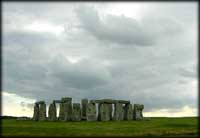 They say that Stonehenge has been spoiled by the crowds and the roads. Perhaps it has.
But I have seen ancient monuments in worse positions and in worse condition. On this day, the visitors were sparse enough and very
respectful without the unruly teenage element that characterises so many societies. The sky was dramatic. So it was still possible to
gain an inkling of the tranquility of the site and the majesty of the stones. For that is all they are, just stones. They say that Stonehenge has been spoiled by the crowds and the roads. Perhaps it has.
But I have seen ancient monuments in worse positions and in worse condition. On this day, the visitors were sparse enough and very
respectful without the unruly teenage element that characterises so many societies. The sky was dramatic. So it was still possible to
gain an inkling of the tranquility of the site and the majesty of the stones. For that is all they are, just stones.Their usage is uncertain and even if it were more certain, there has been a considerable break in their lineage as props for a society. They remain as a monument only. |
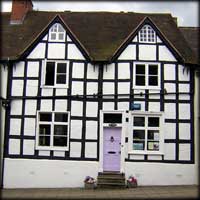 This house in Warwick
is in the Tudor style. This style abounds around rural England, and with the added thatch roofing, accounts for the quaintness of the
style. Even though white seems such an impractical colour. This house in Warwick
is in the Tudor style. This style abounds around rural England, and with the added thatch roofing, accounts for the quaintness of the
style. Even though white seems such an impractical colour.Go to top of page |
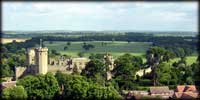 If you ever climb the church tower in Warwick, you will be rewarded with a view over the
castle and, further away, the countryside. Be warned though, the stairway is sandstone, like the remainder of the building, in a spiral
formation (clockwise if you must know) with 160 steps (Al is always counting them, I do not know where she gets it from), and the spiral,
for some unaccountable reason, narrows towards the top. So that at the exit, it is almost impossible for a very tall person to get out. If you ever climb the church tower in Warwick, you will be rewarded with a view over the
castle and, further away, the countryside. Be warned though, the stairway is sandstone, like the remainder of the building, in a spiral
formation (clockwise if you must know) with 160 steps (Al is always counting them, I do not know where she gets it from), and the spiral,
for some unaccountable reason, narrows towards the top. So that at the exit, it is almost impossible for a very tall person to get out.
And since the church itself is on the top of a hill, as many of the churches are, the surrounding view is comprehensive. You can even see to Stratford on Avon, where another mystery survives - who really wrote the plays and other works attributed to William Shakespeare? That is the question. |
 Warwick Castle up close, with impressive ramparts and a surrounding moat (now dry).
While perhaps not so impressive in today's world, in its day it was a formidable defence. And, as the inside shows, a comfortable
home for those privileged to live in it. Warwick Castle up close, with impressive ramparts and a surrounding moat (now dry).
While perhaps not so impressive in today's world, in its day it was a formidable defence. And, as the inside shows, a comfortable
home for those privileged to live in it.
|
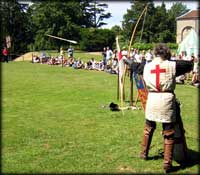 The Warwick Bowman as he styles himself gave a very good illustration of the life of a bowman, and
an impressive demonstration of their skills. Up on the ramparts, looking down on the enemy, he would have been a formidable killer.
Sending off 10 to 12 arrows a minute, with a range up to 250 yards, he is definitely dangerous. The bow he is using here requires 90
pounds of pressure to draw. The true action is surprisingly quick, no holding it in place to aim. The aiming happens at the instant the
bow is fully drawn, which is the same instant it is released. The Warwick Bowman as he styles himself gave a very good illustration of the life of a bowman, and
an impressive demonstration of their skills. Up on the ramparts, looking down on the enemy, he would have been a formidable killer.
Sending off 10 to 12 arrows a minute, with a range up to 250 yards, he is definitely dangerous. The bow he is using here requires 90
pounds of pressure to draw. The true action is surprisingly quick, no holding it in place to aim. The aiming happens at the instant the
bow is fully drawn, which is the same instant it is released.
|
G'day . . . . . . . . . . . . . . . . . . . . . . . . . . . . . . . . . week ending 20 June |
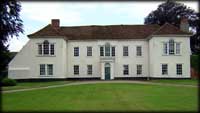 The highlight of this week was definitely the visit to Milden Hall near Sudbury in Suffolk. Now I know that after
reading about our visit there, you will want to visit yourselves. So, click here to go to Milden
Hall website, which is much more interesting than this one. The highlight of this week was definitely the visit to Milden Hall near Sudbury in Suffolk. Now I know that after
reading about our visit there, you will want to visit yourselves. So, click here to go to Milden
Hall website, which is much more interesting than this one.This is the front of the house which looks over a meadow and then fields behind. The house is a sixteenth century hall farmhouse. The rooms for Bed and Breakfast are the upper floor. As well, there are farm nature walks through woodland, green lanes, past castle earthworks and wheatfields. The atmosphere is definitely children-friendly with plenty of activities for the wee ones. Remember that Frecko recommended it to you. |
 This is the view from inside the walled garden. That upper left window was our room with
lovely views of the garden. The path leads to the kitchen, the lawn is vast and includes croquet, and behind me is the tennis court. This is the view from inside the walled garden. That upper left window was our room with
lovely views of the garden. The path leads to the kitchen, the lawn is vast and includes croquet, and behind me is the tennis court.But don't just take my word for it. |
 This is the outside of the recently restored tudor barn, with a lot of care taken to
preserve the original features of the building. This is the outside of the recently restored tudor barn, with a lot of care taken to
preserve the original features of the building.
Go to top of page |
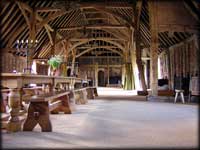 The lovely interior. Big enough for parties, weddings, receptions, coronations, you can even
close off the end for sleeping, or there is a separate self-catering end to the barn. A great place to spend a week, or even a month.
Heck, why not six months? The lovely interior. Big enough for parties, weddings, receptions, coronations, you can even
close off the end for sleeping, or there is a separate self-catering end to the barn. A great place to spend a week, or even a month.
Heck, why not six months?
You gotta love that ceiling. |
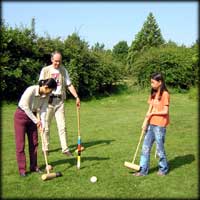 Spend a leisurely hour on the
croquet lawn with the family and discover who isn't a team player. Better to know now rather than later in your dottage, when it
will be too late. Spend a leisurely hour on the
croquet lawn with the family and discover who isn't a team player. Better to know now rather than later in your dottage, when it
will be too late.
Put those rusty golfing skills to use. Savour the crack of wood on wood. Go out in the midday sun. Make the agonising decision to croquet someone or not to croquet. |
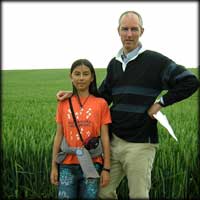 Go for a wander around the farm tracks and
startle the deer, flush the pheasant, surprise the rabbits and follow the trail of the fox. Go for a wander around the farm tracks and
startle the deer, flush the pheasant, surprise the rabbits and follow the trail of the fox.
Marvel at the density of the English wheatfield. If your Australian, take a really good look, it won't be like that when you get home. Take a family member and explain that to them. |
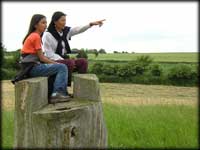 Wander down the paddock to where a wooden castle with a one hundred foot tower was built in
1050 (yes, that is 946 years ago) and wonder why it was razed 100 years later. The mound remains, on top of which once flourished
an oak tree that lived for several hundred years, with only the stump remaining, cleverly fashioned into a castel turret. Wander down the paddock to where a wooden castle with a one hundred foot tower was built in
1050 (yes, that is 946 years ago) and wonder why it was razed 100 years later. The mound remains, on top of which once flourished
an oak tree that lived for several hundred years, with only the stump remaining, cleverly fashioned into a castel turret.
Climb the turret and marvel at the English countryside. Close your eyes, then do it again. |
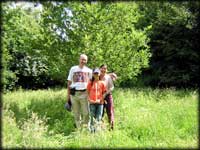 Walk the rides through the 'new forest' planted in 1989 and looking wonderful for 15 year's growth. Walk the rides through the 'new forest' planted in 1989 and looking wonderful for 15 year's growth.
The forest planting and maintenance is a reflection of the conservation principles practiced by the present incumbents. And, might I say, it is award-winning practice. |
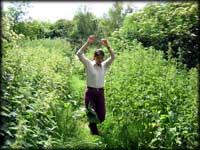 Dance in the forest glades - clothing optional - by yourself if partners are scarce. As
the mood takes you - and it will. Dance in the forest glades - clothing optional - by yourself if partners are scarce. As
the mood takes you - and it will.
Alternatively, for those with stinging nettle phobias, keep your arms raised on entering the ride. |
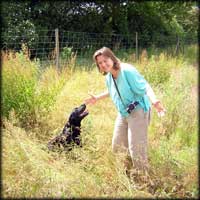 If your luck is really
in, the delightful hostess with the mostess will take you for a wander down to the latest new forest. A lot of the small trees have
been planted by children groups in the last two years and a lot of plants sown by innovative methods.
Remember to close the gate to keep the rabbits and hares out. This protects the seedlings. If your luck is really
in, the delightful hostess with the mostess will take you for a wander down to the latest new forest. A lot of the small trees have
been planted by children groups in the last two years and a lot of plants sown by innovative methods.
Remember to close the gate to keep the rabbits and hares out. This protects the seedlings.Another 15 years and this spot will be flush with forest, and Juliet will be standing in the shade (if that is possible). A tribute indeed. |
 Arrive at the right time of
year and the seasonal fresh produce from the garden will be raspberries. Beautiful. And that is just the picker. Arrive at the right time of
year and the seasonal fresh produce from the garden will be raspberries. Beautiful. And that is just the picker.
Tasty too. Go to top of page |
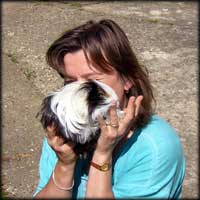 The family guinea pigs
in the kitchen garden have been variously described as 'just delicious' and even 'scrumptious'. The family guinea pigs
in the kitchen garden have been variously described as 'just delicious' and even 'scrumptious'.
They say the proof of the pudding is in the eating.... |
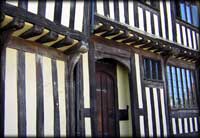 Visit nearby Lavenham village and be impressed by buildings that defy the plumbline. Visit nearby Lavenham village and be impressed by buildings that defy the plumbline.
Great old houses built hundreds of years ago with their great oak beams. One is interesting. A whole street impressive. A whole village extraordinary. |
 Now the top half of this house
may look like it is about to fall, but like the tower in Pisa, it has been that way for a long time,
and hasn't fallen yet. In fact, if it is anything like the Pisa tower, it was never straight. Now the top half of this house
may look like it is about to fall, but like the tower in Pisa, it has been that way for a long time,
and hasn't fallen yet. In fact, if it is anything like the Pisa tower, it was never straight.
This is one of the enigmas of these tudor houses. Were they built to the camber of the timber with the slant, or have they gradually deformed to their present positions? Perhaps the buiilders, architects or historians among you can tell me? |
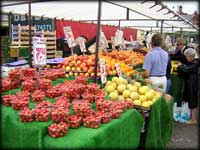 The English market. In this case, Sudbury in Suffolk. And at this time of year, bursting with lovely
English strawberries. The English market. In this case, Sudbury in Suffolk. And at this time of year, bursting with lovely
English strawberries.
Yummmmm. |
 Back through London, the highlight of our last day there being a visit to Tower Bridge. Juat as we
walked down past the Tower of London, the bridge opened up for a tall masted ship! Considering it opens over 300 times a year,
perhaps it is not such a rare event, but it was interesting nonetheless. Back through London, the highlight of our last day there being a visit to Tower Bridge. Juat as we
walked down past the Tower of London, the bridge opened up for a tall masted ship! Considering it opens over 300 times a year,
perhaps it is not such a rare event, but it was interesting nonetheless.
The tour of Tower Bridge was interesting too, as was the view from the upper walkway. |
 When you see those white cliffs of Dover, you are either coming or going. Not to know which is a common problem.
When you see those white cliffs of Dover, you are either coming or going. Not to know which is a common problem.
In our case, this time, we were going. Boo hoo. Gotta love that blue sky. Europe, and perhaps England itself, produces the best blue I see. The Australian version is certainly much paler and washed-out. Which is not how we feel after two weeks in lovely English sunshine. Not a wet day - can you believe that? |
G'day . . . . . . . . . . . . . . . . . . . . . . . . . . . . . . . . . week ending 27 June |
|
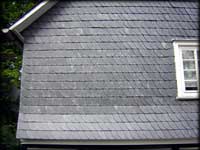 Having successfully negotiated French territory without terrorist incident, we arrived in Siegen, Germany after a trip through Belgium. Siegen is in the mountains roughly halfway between Cologne and Frankfurt. It is unlikely to be on the tourist maps. But one thing about Siegen and the surrounding towns you know immediately, there must be some slate mines, or else it is very cheap. So many of the houses have slate rooves, but also slate walls! I do not think that I have seen that anywhere else before. A lot of plain patterns like this one, but many with embellishments that such a tricky material will allow you. The trouble is that once you overlap two or three tiles, it projects a fair way from the wall. Having successfully negotiated French territory without terrorist incident, we arrived in Siegen, Germany after a trip through Belgium. Siegen is in the mountains roughly halfway between Cologne and Frankfurt. It is unlikely to be on the tourist maps. But one thing about Siegen and the surrounding towns you know immediately, there must be some slate mines, or else it is very cheap. So many of the houses have slate rooves, but also slate walls! I do not think that I have seen that anywhere else before. A lot of plain patterns like this one, but many with embellishments that such a tricky material will allow you. The trouble is that once you overlap two or three tiles, it projects a fair way from the wall. |
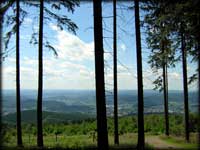 There are a lot of forest trails in the area, well set out, well maintained. The forests are really European in nature - tall trees, mainly pine, very little grass where the trees are dense, very little light filtering through and a dry leaf litter on the ground. A spooky sort of density and light. And clearly a sustainable resource as selective logging is carried out. There are a lot of forest trails in the area, well set out, well maintained. The forests are really European in nature - tall trees, mainly pine, very little grass where the trees are dense, very little light filtering through and a dry leaf litter on the ground. A spooky sort of density and light. And clearly a sustainable resource as selective logging is carried out.This is the one sunny day we had in a week of being of Germany. It is as if the previous four months of fine weather for our journeying needed some sort of balancing out. |
 Near Siegen is Freudenberg, a town unremarkable but for its collection of very old wooden houses. In the tudor style of England, they have the exposed wooden beams on the outside of the houses, except for the odd one now covered with a slate exterior. All of them are otherwise white. Near Siegen is Freudenberg, a town unremarkable but for its collection of very old wooden houses. In the tudor style of England, they have the exposed wooden beams on the outside of the houses, except for the odd one now covered with a slate exterior. All of them are otherwise white.With us we have the daughter of MF's friend, Malin, from Siegen. |
 The design of some of these houses seems symmetrical and yet there are always some oddly placed beams. Could this be by design? Or were builders just making use of the shapes of wood they had available? But what has to be said is that these houses rank in age with the tudor houses in England (1600s), like the village of Lavenham in Suffolk, and yet appear to be less contorted with fewer beams showing. The design of some of these houses seems symmetrical and yet there are always some oddly placed beams. Could this be by design? Or were builders just making use of the shapes of wood they had available? But what has to be said is that these houses rank in age with the tudor houses in England (1600s), like the village of Lavenham in Suffolk, and yet appear to be less contorted with fewer beams showing. |
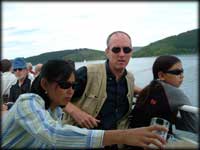 Also not far from Siegen, taking advantage of the fine day, is Olpe. Where there is a lake used mainly for recreational sailing, and probably as a water supply too as there were no power boats allowed. The lake is quite long, so there is a ferry service to get from one end to the other. The trip takes two hours and is a pleasant way to see some of the forests, the lake and some nude sunbathers on the shores (hey, they were a long way away). Also not far from Siegen, taking advantage of the fine day, is Olpe. Where there is a lake used mainly for recreational sailing, and probably as a water supply too as there were no power boats allowed. The lake is quite long, so there is a ferry service to get from one end to the other. The trip takes two hours and is a pleasant way to see some of the forests, the lake and some nude sunbathers on the shores (hey, they were a long way away). |
 Behind the bigger sailboat is a school of children learning to sail in little boats about five feet long - little dinkies. Up on the right is a wind generator. These are fairly common around the landscape and illustrate the German approach to sustainability that includes very good recycling facilities, deposits on drink bottles so they are returned for recycling, paying for plastic bags at supermarkets.... Behind the bigger sailboat is a school of children learning to sail in little boats about five feet long - little dinkies. Up on the right is a wind generator. These are fairly common around the landscape and illustrate the German approach to sustainability that includes very good recycling facilities, deposits on drink bottles so they are returned for recycling, paying for plastic bags at supermarkets....One of the consequences of this is that there is virtually no rubbish in public places - in direct contrast to where we are going next - Cambodia. Go to top of page |
Want to send Frecko a message? Click here: frecko@large